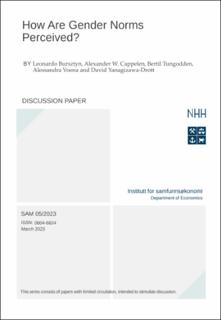| dc.description.abstract | Actual and perceived gender norms are key to understanding gender inequality. Using newly-collected, nationally representative datasets from 60 countries covering 80% of the world population, this paper studies gender norms on two policy issues: basic rights, allowing women to work outside of the home, and affirmative action, prioritizing women when hiring for leadership positions. Misperceptions of gender norms are pervasive across the world, and the nature of the misperception is context-dependent. In less gender-equal countries, people underestimate support for both policies, particularly support among men; in more gender-equal countries, people overestimate support for affirmative action, particularly support among women, and underestimate support for basic rights. Gender stereotyping and overweighting of minority views are potential drivers of the global patterns of misperceptions. Our findings indicate how misperceptions of gender norms may obstruct progress toward gender equality and contribute to sustaining gender policies that are not necessarily favored by women. | en_US |
